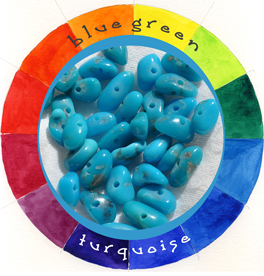b l u e g r e e n
Blue-green has many names: aqua, teal, turquoise, cerulean, aquamarine and cyan are but a few of the
names applied to this popular color. In fact, the Crayola color "Cerulean" ranked second behind
"Blue" as the most popular color. It's associated with open communication and clarity
of thought, and as a blue color, tends to promote relaxation and harmony. The gemstone turquoise
will be found here, as well as apatite, some amazonite and aquamarine, and chrysoprase.
•• d e s i g n s f e a t u r i n g b l u e g r e e n
f u n f a c t s :

Blue-greens have all the benefits of the color blue without the melancholy associations.
Elton John didn't sing, "I guess that's why they call it the teals." Aquas won't
sentence you to death! (Leonard Cohen) Live light and long with these gorgeous colors.
Turquoise is an obvious gemstone in jewelry, but apatite, indicolite (blue-green tourmaline), chrysoprase,
aquamarine, blue topaz, amazonite and blue opal are also beautiful stones that can be blue-green in
color. Turquoise is a porous mineral
so it is common for it to be soaked in wax or impregnated with polymer plastic to stabilize the material
against wear. Some turquoise may be dyed to enhance its color, especially to contrast with a dark
matrix from a host rock. The higher quality - and more expensive - turquoise are not dyed and may or
may not include matrix, depending on the source. Aquamarine is commonly heated to remove yellow color
and enhance the bright blue tones. Most blue topaz in bead form results from irradiating and heating
white topaz and has been found to be a safe and permanent treatment method.
Swarovski crystal colors "aquamarine", "light turquoise" and "blue zircon" are
good blue-green colors, and blue-green is very popular for lampwork glass and sea glass. Darker hues of
blue-green work well for dyed pearls; the lighter shades can make the pearls seem washed out or
plastic in appearance.

 Blue-greens have all the benefits of the color blue without the melancholy associations.
Elton John didn't sing, "I guess that's why they call it the teals." Aquas won't
sentence you to death! (Leonard Cohen) Live light and long with these gorgeous colors.
Turquoise is an obvious gemstone in jewelry, but apatite, indicolite (blue-green tourmaline), chrysoprase,
aquamarine, blue topaz, amazonite and blue opal are also beautiful stones that can be blue-green in
color. Turquoise is a porous mineral
so it is common for it to be soaked in wax or impregnated with polymer plastic to stabilize the material
against wear. Some turquoise may be dyed to enhance its color, especially to contrast with a dark
matrix from a host rock. The higher quality - and more expensive - turquoise are not dyed and may or
may not include matrix, depending on the source. Aquamarine is commonly heated to remove yellow color
and enhance the bright blue tones. Most blue topaz in bead form results from irradiating and heating
white topaz and has been found to be a safe and permanent treatment method.
Swarovski crystal colors "aquamarine", "light turquoise" and "blue zircon" are
good blue-green colors, and blue-green is very popular for lampwork glass and sea glass. Darker hues of
blue-green work well for dyed pearls; the lighter shades can make the pearls seem washed out or
plastic in appearance.
Blue-greens have all the benefits of the color blue without the melancholy associations.
Elton John didn't sing, "I guess that's why they call it the teals." Aquas won't
sentence you to death! (Leonard Cohen) Live light and long with these gorgeous colors.
Turquoise is an obvious gemstone in jewelry, but apatite, indicolite (blue-green tourmaline), chrysoprase,
aquamarine, blue topaz, amazonite and blue opal are also beautiful stones that can be blue-green in
color. Turquoise is a porous mineral
so it is common for it to be soaked in wax or impregnated with polymer plastic to stabilize the material
against wear. Some turquoise may be dyed to enhance its color, especially to contrast with a dark
matrix from a host rock. The higher quality - and more expensive - turquoise are not dyed and may or
may not include matrix, depending on the source. Aquamarine is commonly heated to remove yellow color
and enhance the bright blue tones. Most blue topaz in bead form results from irradiating and heating
white topaz and has been found to be a safe and permanent treatment method.
Swarovski crystal colors "aquamarine", "light turquoise" and "blue zircon" are
good blue-green colors, and blue-green is very popular for lampwork glass and sea glass. Darker hues of
blue-green work well for dyed pearls; the lighter shades can make the pearls seem washed out or
plastic in appearance.